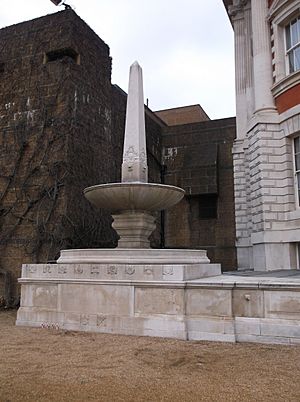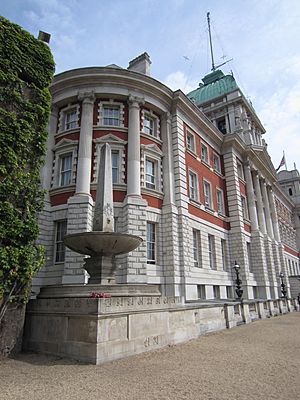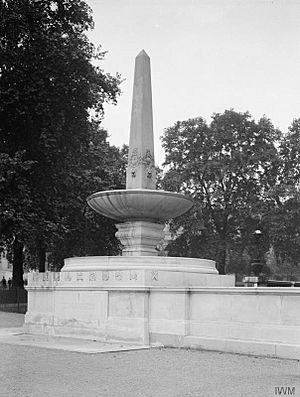Royal Naval Division War Memorial facts for kids
Quick facts for kids Royal Naval Division Memorial |
|
|---|---|
| United Kingdom | |
 |
|
| For members of the 63rd (Royal Naval) Division killed in the First World War | |
| Unveiled | 25 April 1925 |
| Location | 51°30′19″N 0°07′45″W / 51.505348°N 0.129056°W Horse Guards Parade, London
|
| Designed by | Sir Edwin Lutyens |
|
IN MEMORY OF THE OFFICERS AND OTHER RANKS OF THE ROYAL NAVAL DIVISION WHO GAVE THEIR LIVES FOR THEIR COUNTRY
|
|
|
Listed Building – Grade II
|
|
| Official name | The Royal Naval Division Memorial |
| Designated | 6 March 2008 |
| Reference no. | 1392454 |
The Royal Naval Division Memorial is a special monument in central London. It stands on Horse Guards Parade and honors the brave members of the 63rd (Royal Naval) Division (RND) who died during the First World War. Sir Edwin Lutyens, a famous architect, designed this memorial. It was officially revealed on April 25, 1925. This date was exactly ten years after the Gallipoli landings, where the division faced many challenges and lost many soldiers.
After the war, former members of the RND wanted to create a memorial. They formed a group led by Brigadier-General Arthur Asquith. At first, they hoped to join a bigger project by the Royal Navy. But when that plan didn't happen, the RND group decided to build their own memorial. They hired Lutyens, who designed a beautiful fountain connected to the balustrade of the Admiralty Extension building.
Lutyens' design features a tall, pointed stone pillar called an obelisk. It rises from a round bowl, with water flowing from lion heads at its base. The memorial also has carvings of the RND's unit symbols and a poem by Rupert Brooke. Brooke was a poet who served in the division and sadly died in 1915. Major-General Sir Archibald Paris, the division's first leader, unveiled the memorial. Winston Churchill, who created the division, gave a powerful speech praising the memorial and the RND's service.
In 1939, the memorial was taken apart and stored away during the Second World War. This was done to build the Admiralty Citadel. It was put back together in 1951 at the Royal Naval College in Greenwich. When the college closed in the late 1990s, people worked to move the memorial back to its original spot. It was unveiled again in 2003, and Churchill's grandson read his grandfather's original speech. The memorial is now a protected historic site, known as a grade II* listed building.
Contents
The Royal Naval Division (RND) was a special group of soldiers during the First World War. Even though it was called "Naval," it fought on land. Winston Churchill, who was in charge of the Royal Navy at the time, created it in 1914. He brought together sailors, Royal Marines, and reservists who weren't needed on ships.
The RND was known for its strong naval traditions, even using naval ranks like "Captain" for land officers. Their first battles were in Belgium in 1914, defending cities like Antwerp. In 1915, the RND was part of the Gallipoli Campaign in Turkey. This was a very difficult campaign where they suffered many losses.
After Gallipoli, the division was reorganized in 1916. It became the 63rd (Royal Naval) Division and joined the British Army. They kept their unique naval character but fought on the Western Front until the war ended in 1918. The division was officially disbanded in June 1919. During the war, the RND lost over 10,000 officers and men, and many more were wounded.
How the Memorial Was Planned

Right after the war, former members of the Royal Naval Division wanted to create a memorial. They formed a committee led by Brigadier-General Arthur Asquith. He was the son of H. H. Asquith, who was the British Prime Minister during the first part of the war.
The committee wanted the memorial to be in London. They first hoped to put it in Trafalgar Square, a very famous spot. However, the government office in charge of public works felt their budget of £3,000 was not enough for such a big location. Other ideas, like a site along the River Thames, were suggested but turned down by the committee.
Things started to move forward when Asquith talked to Sir Edwin Lutyens. Lutyens began discussing possible locations with the Office of Works. They suggested a fountain behind the Admiralty Extension building. This spot was approved by King George V in July 1924.
What the Memorial Looks Like
The Royal Naval Division Memorial is made from Portland stone, a type of white limestone. It has a tall, pointed stone pillar, or obelisk, that stands out from a round bowl. This bowl sits on a square base, which connects to another, shallower bowl and a large square platform. This platform extends from the wall of the old Admiralty Extension building on Horse Guards Parade.
On each of the four sides of the obelisk's base, you can see carved symbols of the Royal Naval Division. Below these symbols are sculpted lion heads. Water flows from the mouths of these lions into the basin below. The obelisk itself is about 7.5 meters (25 feet) tall. The widest part of the platform is about 4.7 meters (15 feet) across.
On the front and left sides of the platform, there are carvings of 18 cap badges. These are the symbols worn on the hats of the units that were part of the division. The memorial also has important words carved into it. On the front, it shows the years of the First World War: "1914" and "1918." Below this is the main dedication: "IN MEMORY OF THE OFFICERS AND OTHER RANKS OF THE ROYAL NAVAL DIVISION WHO GAVE THEIR LIVES FOR THEIR COUNTRY."
Other carvings list the division's battle honors, like "SALONIKA 1916" and "FRANCE AND BELGIUM 1916–1918." On the left side, there's a verse from a poem called "III: The Dead" by Rupert Brooke. Brooke was a war poet and a member of the RND who died in 1915.
Blow out, you bugles, over the rich Dead!
There's none of these so lonely and poor of old,
But, dying, has made us rarer gifts than gold.
These laid the world away; poured out the red
Sweet wine of youth; gave up the years to be
Of work and joy, and that unhoped serene,
That men call age; and those who would have been,
Their sons, they gave, their immortality.
Rupert Brooke, 1887–1915, Hood Battalion
At the very bottom of the platform, there are more cap badges and the names of two battalions from the division: "BENBOW" and "COLLINGWOOD." A stone panel also tells the story of the memorial: "THIS MEMORIAL DESIGNED BY SIR EDWIN LUTYENS WAS UNVEILED ON THE HORSE GUARDS PARADE AT THE CORNER OF THE ADMIRALTY ON APRIL 25TH 1925 THE TENTH ANNIVERSARY OF THE LANDING ON GALLIPOLI. REMOVED IN 1940, ERECTED IN GREENWICH IN 1951 AND REINSTATED ON THIS SITE IN 2003."
History of the Memorial
The memorial was officially revealed by Major-General Sir Archibald Paris on April 25, 1925. This was exactly ten years after the Gallipoli landings. Many important people attended, including Winston Churchill, who gave a powerful speech. He praised the memorial's design and the brave service of the Royal Naval Division. Churchill said the memorial would "give forth not only the waters of honour, but the waters of healing and the waters of hope."
The money for the memorial came from private donations, mostly from former members of the division or the families of those who died. A very large donation came from Lord Rothermere, whose son died fighting with the division. The government agreed to help with the memorial's ongoing care.
Soon after it was built, some small problems were found with the fountain, like the water not flowing evenly. The RND Association paid for repairs. Later, the government agreed to cover the costs of future repairs and maintenance.
In 1939, the memorial was taken apart and stored away to protect it during the Second World War. It was kept in different places, including the grounds of the Royal Hospital Chelsea. After the war ended in 1945, the RND Association worked hard to have the memorial put back up.
The government decided it couldn't go back to its original spot right away. After looking at many other places, they agreed in 1949 to rebuild it at the Royal Naval College in Greenwich. It was unveiled there on May 26, 1951.
Former members of the division had mixed feelings about the new location. It wasn't as visible as central London, but it became a gathering place for them. When the college was going to close in the late 1990s, a campaign started to move the memorial back to Horse Guards Parade.
After some restoration work, the memorial was finally put back in its original spot on November 13, 2003. This date was the anniversary of a major battle the division fought in 1916. Prince Charles (now King Charles III) unveiled it, and Churchill's grandson read his grandfather's speech from the first ceremony.
In 2008, the memorial was given "grade II" listed building status, which means it's an important historic building that needs to be protected. In 2015, its status was upgraded to "grade II*," meaning it's even more important. This happened as part of a national effort to recognize Lutyens' war memorials for the 100th anniversary of the First World War.




